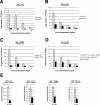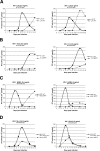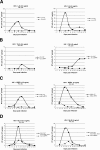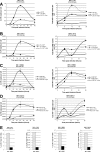Nuclear import defect of human immunodeficiency virus type 1 DNA flap mutants is not dependent on the viral strain or target cell type
- PMID: 17005705
- PMCID: PMC1617309
- DOI: 10.1128/JVI.00974-06
Nuclear import defect of human immunodeficiency virus type 1 DNA flap mutants is not dependent on the viral strain or target cell type
Abstract
We have previously established, using human immunodeficiency virus type 1 (HIV-1) strain LAI, that the HIV-1 central DNA Flap acts as a cis determinant of viral genome nuclear import. Although the impact of the DNA Flap on nuclear import has already found numerous independent confirmations in the context of lentivirus vectors, it has been claimed that it may be nonessential for infectious virus strains LAI, YU-2 (J. D. Dvorin et al., J. Virol. 76:12087-12096, 2002), HXB2, and NL4-3 (A. Limon et al., J. Virol. 76:12078-12086, 2002). We conducted a detailed analysis of virus infectivity using the provirus clones provided by the authors and analogous target cells. In contrast to published data, our results show that all cPPT mutant viruses exhibit reduced infectivity corresponding to a nuclear import defect irrespective of the viral genetic background or target cell.
Figures




Similar articles
-
HIV-1 genome nuclear import is mediated by a central DNA flap.Cell. 2000 Apr 14;101(2):173-85. doi: 10.1016/S0092-8674(00)80828-4. Cell. 2000. PMID: 10786833
-
The central DNA flap of the human immunodeficiency virus type 1 is important for viral replication.Biochem Biophys Res Commun. 2006 Oct 27;349(3):1100-10. doi: 10.1016/j.bbrc.2006.08.141. Epub 2006 Aug 31. Biochem Biophys Res Commun. 2006. PMID: 16962998
-
Wild-type and central DNA flap defective HIV-1 lentiviral vector genomes: intracellular visualization at ultrastructural resolution levels.Retrovirology. 2006 Jun 26;3:38. doi: 10.1186/1742-4690-3-38. Retrovirology. 2006. PMID: 16800894 Free PMC article.
-
Lentiviral nuclear import: a complex interplay between virus and host.Bioessays. 2007 May;29(5):441-51. doi: 10.1002/bies.20561. Bioessays. 2007. PMID: 17450594 Review.
-
[Nuclear import of retroviruses].Tanpakushitsu Kakusan Koso. 2007 Aug;52(10 Suppl):1214-20. Tanpakushitsu Kakusan Koso. 2007. PMID: 17824242 Review. Japanese. No abstract available.
Cited by
-
Gene delivery by lentivirus vectors.Mol Biotechnol. 2007 Jul;36(3):184-204. doi: 10.1007/s12033-007-0010-8. Mol Biotechnol. 2007. PMID: 17873406 Review.
-
Spastin is required for human immunodeficiency virus-1 efficient replication through cooperation with the endosomal sorting complex required for transport (ESCRT) protein.Virol Sin. 2023 Jun;38(3):448-458. doi: 10.1016/j.virs.2023.05.006. Epub 2023 May 11. Virol Sin. 2023. PMID: 37172824 Free PMC article.
-
Phosphorylation of the HIV-1 capsid by MELK triggers uncoating to promote viral cDNA synthesis.PLoS Pathog. 2017 Jul 6;13(7):e1006441. doi: 10.1371/journal.ppat.1006441. eCollection 2017 Jul. PLoS Pathog. 2017. PMID: 28683086 Free PMC article.
-
The Unique, the Known, and the Unknown of Spumaretrovirus Assembly.Viruses. 2021 Jan 13;13(1):105. doi: 10.3390/v13010105. Viruses. 2021. PMID: 33451128 Free PMC article. Review.
-
CAR-T cell potency: from structural elements to vector backbone components.Biomark Res. 2022 Sep 19;10(1):70. doi: 10.1186/s40364-022-00417-w. Biomark Res. 2022. PMID: 36123710 Free PMC article. Review.
References
-
- Baekelandt, V., A. Claeys, K. Eggermont, E. Lauwers, B. De Strooper, B. Nuttin, and Z. Debyser. 2002. Characterization of lentiviral vector-mediated gene transfer in adult mouse brain. Hum. Gene Ther. 13:841-853. - PubMed
-
- Barry, S. C., B. Harder, M. Brzezinski, L. Y. Flint, J. Seppen, and W. R. Osborne. 2001. Lentivirus vectors encoding both central polypurine tract and posttranscriptional regulatory element provide enhanced transduction and transgene expression. Hum. Gene Ther. 12:1103-1108. - PubMed
-
- Bouyac-Bertoia, M., J. D. Dvorin, R. A. Fouchier, Y. Jenkins, B. E. Meyer, L. I. Wu, M. Emerman, and M. H. Malim. 2001. HIV-1 infection requires a functional integrase NLS. Mol. Cell 7:1025-1035. - PubMed
Publication types
MeSH terms
Substances
LinkOut - more resources
Full Text Sources
Other Literature Sources

